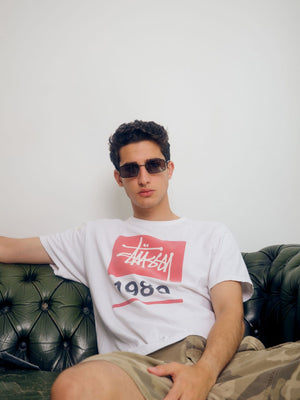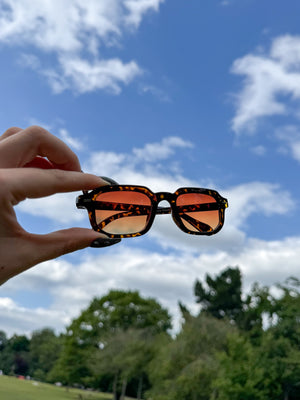
Vintage: How old is it and what is considered ‘vintage’ clothing?
Posted by jonathan kemp on
As circular fashion becomes more mainstream, has ‘vintage’ become a throwaway term? A broadly defined label, do you really know what deserves the vintage seal of approval?
Old School
What is considered by some as ‘true vintage’, old school items are those that date back to before the 1950s. Rare to find, pieces from the 1920s, 1930s or 1940s have been given antique status in recent years, often being incredibly valuable and delicate.
The modern fascination with the likes of Tommy Shelby have inspired a surge in old school fashion, seeing the return of sequins and flat caps. However, finding an authentic piece is never easy or cheap!
Newer School
The next phase on our timeline is the period of newer school fashion, spanning between the 60s and 80s.
The swinging sixties saw an eruption of colour and boldness in its patterns. Whether it was a college sweatshirt, an Alfie-style suit or a pop art mini skirt, the 1960s style maintained the neat chicness of the old school but laid the foundations for a more liberating fashion upheaval in the 1970s. In the decade that championed flares, there were more new styles than men had shirt buttons undone. Chunky heels, tie dye and hot pants, the 70s were loud and broke every boundary.

Figure 1. The style of the newer school.
However, if it was thought that fashion couldn’t go any further, such considerations were blown out of the water by the emergence of 1980s trends that favoured neon leotards and ripped fishnets. A hugely successful decade for athleisure, at Thrifted we have favoured the track jackets, matching tracksuits and vibrant sweatshirts of the 80s.
The newer school holds some of the most coveted labels in the vintage market, such as the Nike pinwheel (see our article on the ‘History of Nike’).
Newest School
The newest school recognises the twenty years that have dominated the vintage fashion industry, comprised of pieces from the 90s and early 2000s (y2k).
Thrifted’s collection is predominantly focused on 90s clothing, from football shirts to worker jackets, and we stock some of the most reputable brands from the decade. The naughties style has made a serious comeback in recent years as oversized sweatshirts and spaghetti straps reappear and double denim returns to favour with fashionistas after ten years of being a wardrobe offence. Take a look at our list of ‘90s Trendsetters’ to see which of the 90s styles is most up your street.
Taking a lot of inspiration from the 90s, y2k fashion sported some familiar themes. Bucket hats and butterfly clips remained staples, paired with baggy cargo pants or the memorable skirt-over-jeans look. Detailed cami tops and oversized shirts would not be out of place today as fashion begins to hark back to the baby-doll and boyband aesthetics.
Depop Definitions
The modern take on eBay, Depop has grown exponentially over the last five years, becoming a must-have app. Allowing individuals to freely buy and sell their items, this mobile marketplace has played a significant role in the spread of circular fashion, promoting ‘vintage’ to its considerable audience, from students to celebrities.

Figure 2. Depop’s mobile explore page.
However, in recognising the desirability of vintage pieces, Depop’s sellers have adopted the term to add value to their listings. You may have come across common phrases such as ‘super vintage’, ‘a real vintage feel’ or the classic ‘a vintage vibe’. Yet, the ambiguity reveals so very much, for the ‘vibe’ is all you receive if you press ‘buy’. This is not to say that that there is no value in these kinds of pieces, monetarily or fashion-speaking, but it is no guarantee that they are the real deal. In using the term, sellers intend to increase their number of viewers and thereby interest in their listings and so ‘vintage’ no longer only indicates an older manufacturing date but has also taken a descriptive role.
Consequently, ‘retro’ has taken a back seat. Now used to identify boldness in colour, patterns and features, the word has also been redefined in recent years. Derived from the Latin prefix ‘retro’, meaning ‘backwards’, retro items can be old or new, but are always made in the style of a previous era or trend; they are a replication. As such, the new items that possess the ‘vintage aesthetic’, as coined by sellers, actually fall into the misunderstood ‘retro’ classification.
What is your definition of vintage?
Everyone has had those moments. The ones when your Dad pulls out his old concert tees, sentimentally telling you that it feels ‘as if it was yesterday’ before looking mildly offended when you call them ‘vintage’. However, it reminds us that how we define ‘vintage’ depends on a number of factors, such as age or a general interaction with fashion. For those that lived through the decades, while items may be from the 80s or 90s, pieces may be recognisably old, but will not possess the same otherworldly qualities that the younger generation appreciate. For the current ‘young’ population, born predominantly after 1990, the naughties fashion that we hold in such esteem has a distance, it is not so different that it seems disconnected, but it holds the revered quality of ‘vintage’.
And so, can we really pinpoint exactly what ‘vintage’ is? Today the term has multiple meanings, being used to identify authenticity as well as style, but also serving different meanings between generations. However, whatever vintage means to you, it is undeniable that it is an eternally evolving term.
References:
www.depop.com
www.revivalvintage.co.uk
www.rookmemorizevoluntary.com





